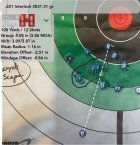Can anybody point me to a collection of data on the accuracy of different hunting rifles based on mean radius based on 10 or more shots (preferably 20 or more) taken in aggregate to allow for adequate cooling between every shot or 2 or 3?
Thanks to the work by Brian Litz as popularized by a variety of blogs, podcasts and the like (https://precisionrifleblog.com/2020/12/12/measuring-group-size-statistics-for-shooters/) I’ve come to believe that:
As a hunter who wants a very high assurance that my gun is capable of hitting the vitals, mean radius is very helpful in that it can be used to calculate the R95 for a group, which is the radius from the group center that will hold 95% of the shots taken. This combined with the bullet’s trajectory can help me judge the confidence I have at shooting at different distances.
My problem is that mean radius is a new (to me) concept and I’ve not been able to find a listing results for other hunting rifles to help me determine how good or terrible my guns are.
Here are two examples. This is my .223 Varmint gun. A 20 shot string fired at a steady slow fire rate.

And here is my Winchester 94 in 32 WSP. 20 shots fired as a series of 7 different 3-shot strings (last string was 2 shots) allowing 20 minutes for the gun to cool off in-between. Accurate enough for the brush but…

Thanks to the work by Brian Litz as popularized by a variety of blogs, podcasts and the like (https://precisionrifleblog.com/2020/12/12/measuring-group-size-statistics-for-shooters/) I’ve come to believe that:
- Individual groups of 3-5 shots don’t provide reliable information (other than the occasional “the combination is terrible and can be excluded”),
- Groups of 10 or more (preferably 20 or more) provide much more significant (and predictive) information, and
- Mean radius provides more information than traditional “group size” (aka extreme spread).
As a hunter who wants a very high assurance that my gun is capable of hitting the vitals, mean radius is very helpful in that it can be used to calculate the R95 for a group, which is the radius from the group center that will hold 95% of the shots taken. This combined with the bullet’s trajectory can help me judge the confidence I have at shooting at different distances.
My problem is that mean radius is a new (to me) concept and I’ve not been able to find a listing results for other hunting rifles to help me determine how good or terrible my guns are.
Here are two examples. This is my .223 Varmint gun. A 20 shot string fired at a steady slow fire rate.

And here is my Winchester 94 in 32 WSP. 20 shots fired as a series of 7 different 3-shot strings (last string was 2 shots) allowing 20 minutes for the gun to cool off in-between. Accurate enough for the brush but…












